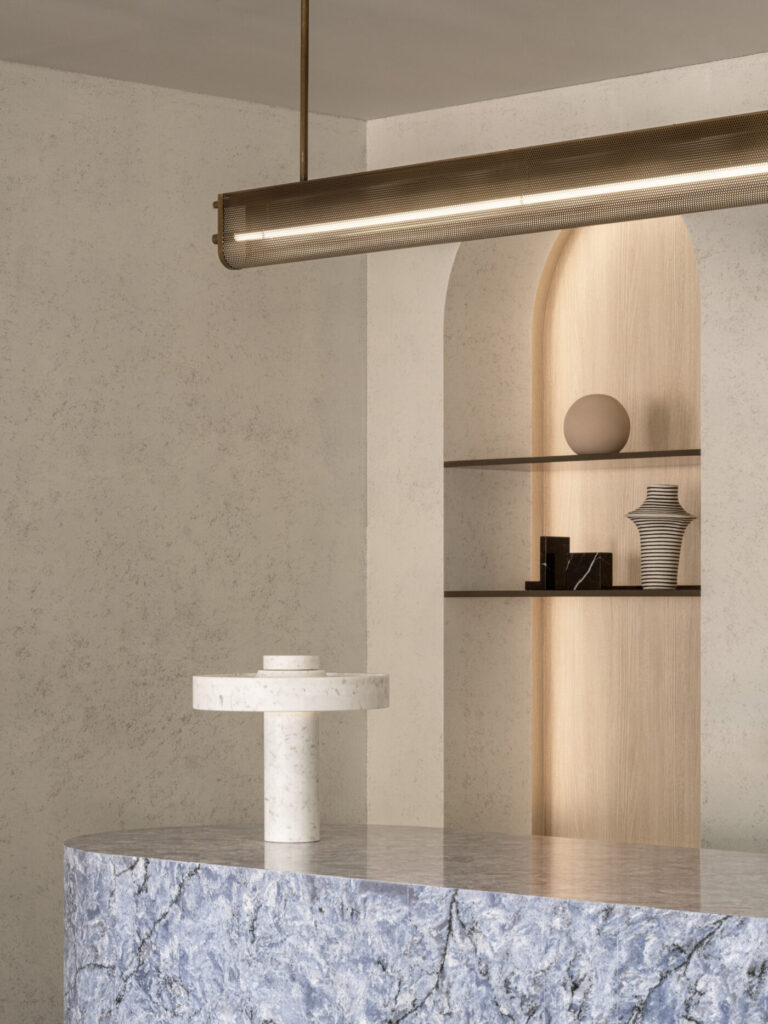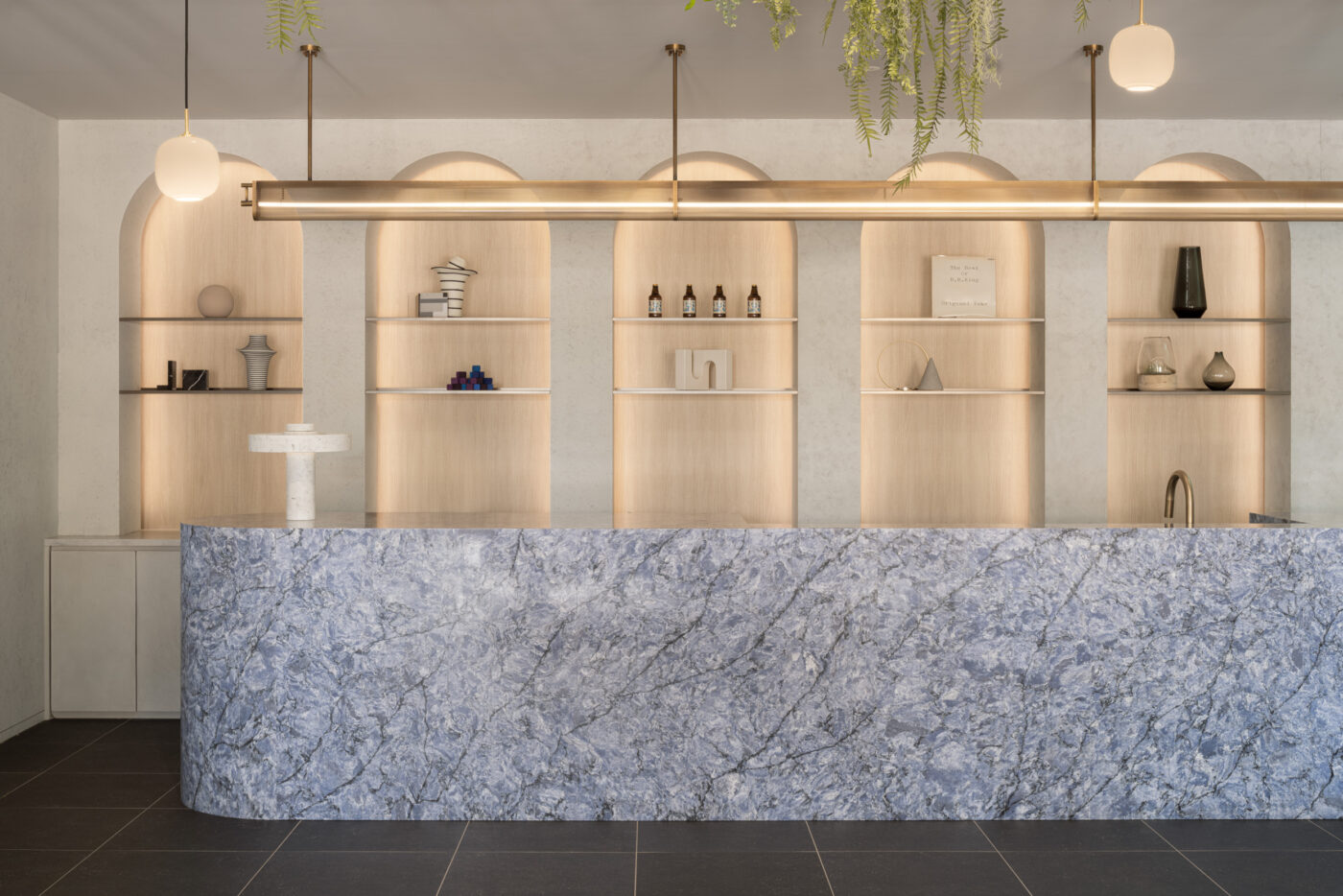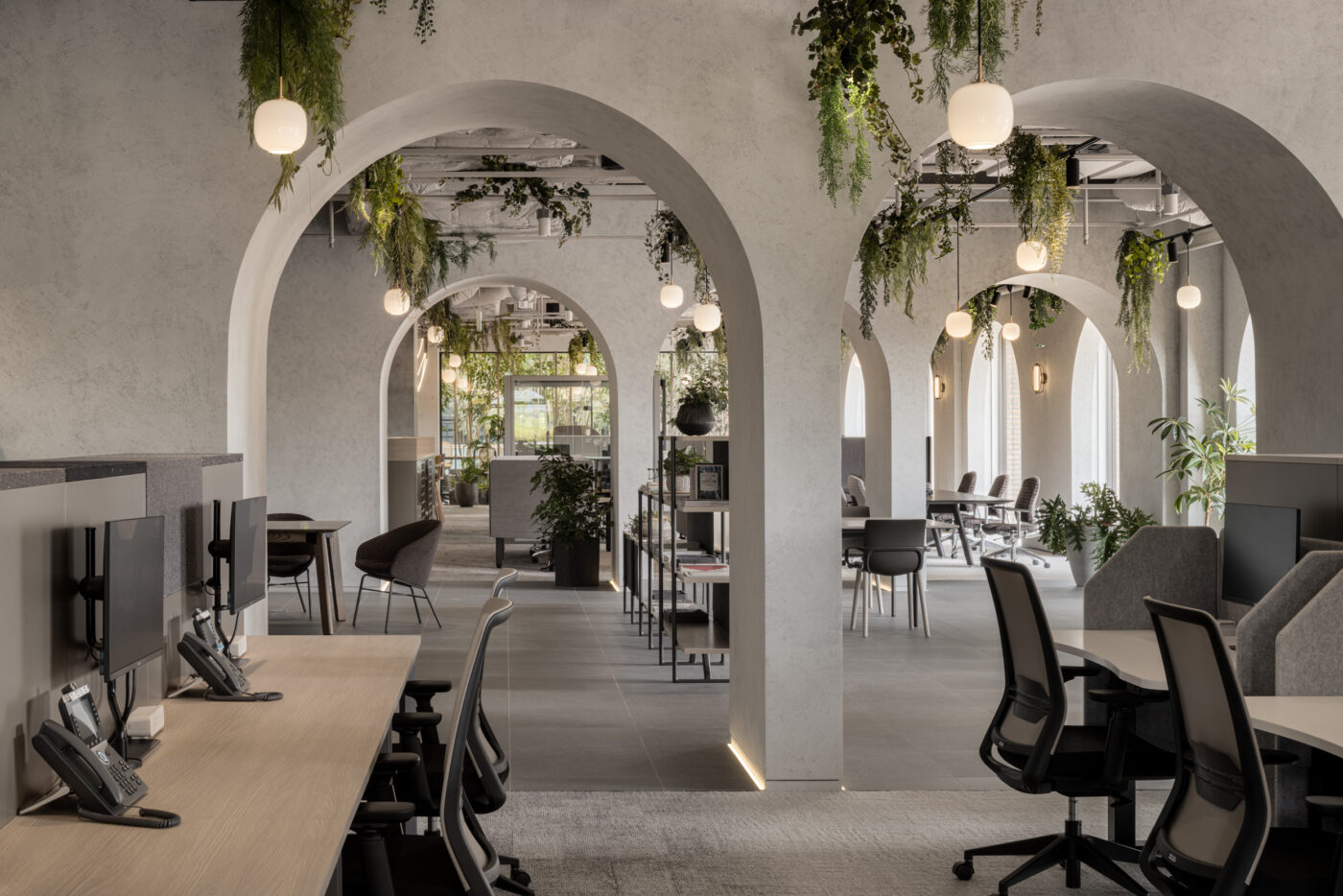PLUS Design Cross
2023
/
Office
JP
EN
今回の対象地は一般的なオフィス空間とは一線を画し、工業的なダクトが縦横無尽に走る天井の高いスケルトン空間。
これまでのショールームとは異なるユニークな空間だ。
スケルトンのデザインといえばパリにある美術館、ポンピドゥーセンターだ。今では多くの人に愛される施設だが、当初はあまりの斬新さにパリの街並みの美観を損ねるとして批判を受けた。しかし設計者のレンゾピアノはそのデザインについて「いかめしい美術館の印象を壊し、芸術と人間の自由な空間を表現する場なのである」と語った。以来、ダクトを剥き出しにするスケルトンは徐々に市民権を得て今では多くの場所で目にするようになった。現在の日本でもまた、スケルトンの空間はカフェやレストラン、リテールショップなどで多くの場所で目にするデザイン手法の一つである。しかし一方で見慣れすぎてしまっているとも言えるかもしれない。また、無機質・工業的といったイメージを持つ人も少なくない。
そこで、ポンピドゥーセンターとは全く逆のアプローチで、スケルトンとは対局の古代から用いられている建築エレメントの一つである「アーチ」を取り入れデザインを構築した。シンプルながらもシンボリックなアーチのデザインがダクトの印象を和らげ、アナログ感、歴史的、ノスタルジックといった温かみのある印象も訪れる人々に与える。スケルトンとアーチ。二つの要素が共存することで、現在と歴史、機能と情緒など相反するイメージが融合し、訪れる人々に多様な感情と、奥行きを感じさせる空間が生まれるのではないかと考えた。
Photo: Tomooki Kengaku
これまでのショールームとは異なるユニークな空間だ。
スケルトンのデザインといえばパリにある美術館、ポンピドゥーセンターだ。今では多くの人に愛される施設だが、当初はあまりの斬新さにパリの街並みの美観を損ねるとして批判を受けた。しかし設計者のレンゾピアノはそのデザインについて「いかめしい美術館の印象を壊し、芸術と人間の自由な空間を表現する場なのである」と語った。以来、ダクトを剥き出しにするスケルトンは徐々に市民権を得て今では多くの場所で目にするようになった。現在の日本でもまた、スケルトンの空間はカフェやレストラン、リテールショップなどで多くの場所で目にするデザイン手法の一つである。しかし一方で見慣れすぎてしまっているとも言えるかもしれない。また、無機質・工業的といったイメージを持つ人も少なくない。
そこで、ポンピドゥーセンターとは全く逆のアプローチで、スケルトンとは対局の古代から用いられている建築エレメントの一つである「アーチ」を取り入れデザインを構築した。シンプルながらもシンボリックなアーチのデザインがダクトの印象を和らげ、アナログ感、歴史的、ノスタルジックといった温かみのある印象も訪れる人々に与える。スケルトンとアーチ。二つの要素が共存することで、現在と歴史、機能と情緒など相反するイメージが融合し、訪れる人々に多様な感情と、奥行きを感じさせる空間が生まれるのではないかと考えた。
Photo: Tomooki Kengaku
The site selected for this new showroom was a high ceilinged undecorated "skeleton" space with its structure exposed and ventilation pipings running in all directions, a unique environment nothing like a typical office space or their previous showroom.
The most renowned skeleton structured building is the Centre Pompidou, a centre for culture and art in Paris housing the National Museum of Modern and Contemporary Art.
It is now celebrated as one of the most popular landmarks in Paris, however the radical design of the building was initinally met with hostility claimed to have been a threat to the beautiful Parisian landscape.
Renzo Piano, designer of the building together with Richard Rogers, declared at the time “to have wanted to demolish the image of a cultural building which frightens. It's the dream of an extraordinarily free relationship between art and people, where you breathe the city at the same time”
Since Centre Pompidou, the skeleton structured design has gradually been recognized and now become one of the commonly applied designs in cafes, restaurants and retail stores here in Japan. However, it has become so common that it may no longer bring excitement to visitors. Additionally, the design can be taken as being cold and industrial.
Therefore, we took a completely opposite approach from that of Centre Pompidou. Instead of introducing something new and radical, we looked back in history and brought back the design element of "arch" which has been used from the ancient times. Simple yet symbolic feature of the arch eases the strong impression of the pipings and adds a warm feeling of analogue, historical and nostalgy to the space. Coexistance of the 2 design elements, skeleton and arch, exhibits the harmony of contradicting factors such as "present & past" and "function & emotion", to showcase the depth of the space and bring various emotions to the visitors.
Photo: Tomooki Kengaku
The most renowned skeleton structured building is the Centre Pompidou, a centre for culture and art in Paris housing the National Museum of Modern and Contemporary Art.
It is now celebrated as one of the most popular landmarks in Paris, however the radical design of the building was initinally met with hostility claimed to have been a threat to the beautiful Parisian landscape.
Renzo Piano, designer of the building together with Richard Rogers, declared at the time “to have wanted to demolish the image of a cultural building which frightens. It's the dream of an extraordinarily free relationship between art and people, where you breathe the city at the same time”
Since Centre Pompidou, the skeleton structured design has gradually been recognized and now become one of the commonly applied designs in cafes, restaurants and retail stores here in Japan. However, it has become so common that it may no longer bring excitement to visitors. Additionally, the design can be taken as being cold and industrial.
Therefore, we took a completely opposite approach from that of Centre Pompidou. Instead of introducing something new and radical, we looked back in history and brought back the design element of "arch" which has been used from the ancient times. Simple yet symbolic feature of the arch eases the strong impression of the pipings and adds a warm feeling of analogue, historical and nostalgy to the space. Coexistance of the 2 design elements, skeleton and arch, exhibits the harmony of contradicting factors such as "present & past" and "function & emotion", to showcase the depth of the space and bring various emotions to the visitors.
Photo: Tomooki Kengaku












